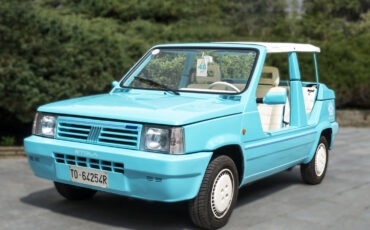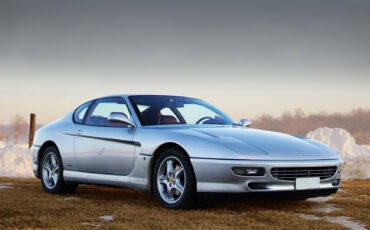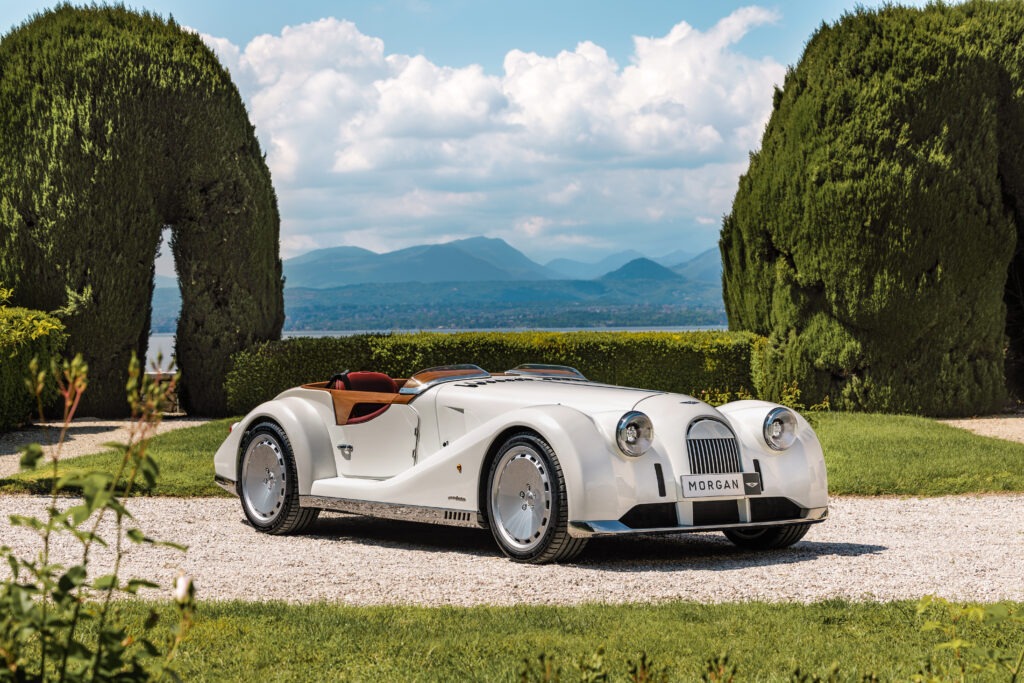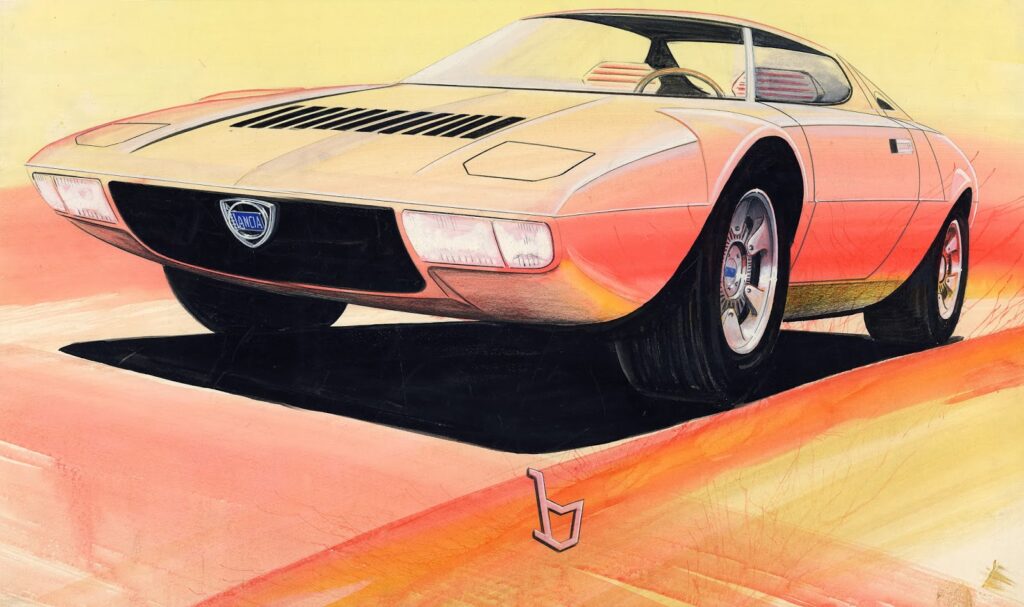
The origin of the Lancia Stratos
Before the Lancia Stratos, if we exclude the “fuoriserie” of the past, Bertone had never officially collaborated with Lancia. To create this opportunity, Bertone, recovering the V4 from a demolished Lancia Fulvia Coupe, built a dreamcar capable of capturing the attention not only of the well-known Turin brand, but also of the public.
The Lancia Stratos Zero was unveiled by Bertone at the 1970 Turin Motor Show; it was presented as a mid-engine sports car project, futuristic in concept for those times. The design by Marcello Gandini, immediately aroused great interest among all visitors of the show for its innovative and “breakthrough” style, especially for a brand like Lancia. Abolishing the doors, one got into the prototype by directly opening the windshield and lowering oneself inside by stepping over the articulated steering column; the rear hood had an unprecedented arrow motif, the rear lights were formed by the simple luminous outline of the tail volume, and the front lights by 10 headlamps side by side on the sharp nose of the car, painted in metallic bronze.
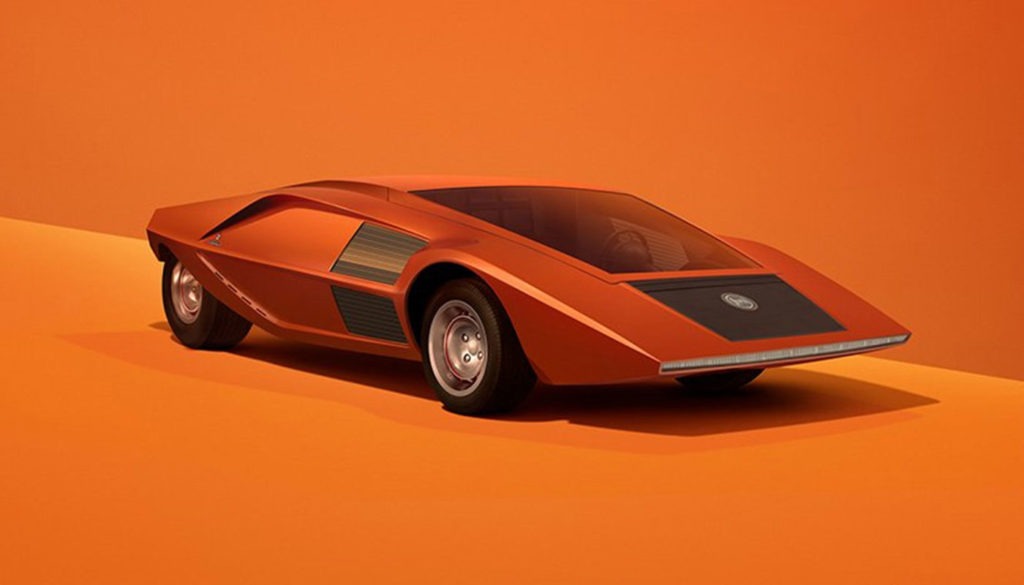
Cesare Fiorio, at the helm of the Lancia HF racing team and in search of a suitable replacement in rallying for the outdated Fulvia Coupé 1600 HF, saw in this mid-engine prototype the right amount of novelty needed for the company, which had joined the Fiat Group the year before. To design the worthy heir to the Fulvia Coupé, Fiorio listened to the opinions of the drivers and technicians of the successful HF racing team and established the basic guidelines: short wheelbase, 2 seats, powerful mid-engine, advanced aerodynamics and exploitability in all conditions (track, road and dirt).
However, international regulations required at least 500 examples of a new car to be built in order to be homologated in Group 4. For this reason, in spring 1971, Cesare Fiorio and Pier Ugo Gobbato, Lancia’s new general manager, who wanted to bring prestige to the company through prestigious international victories, asked Nuccio Bertone to design and produce a car that would be less futuristic than the “Zero” but that, while meeting Fiorio’s demands, would be suitable for mass production, albeit limited.
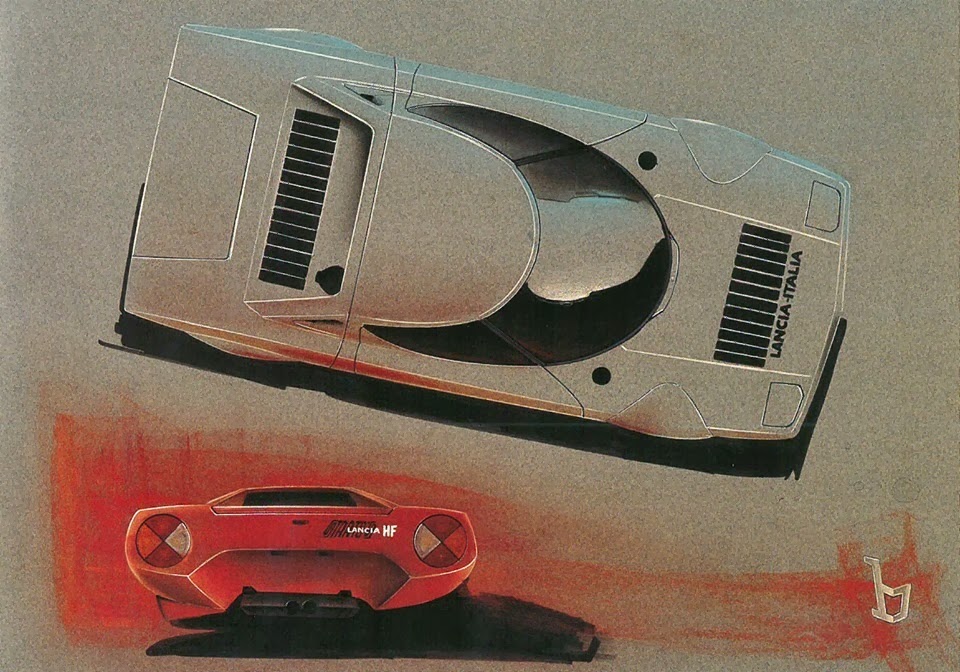
So throughout the summer Carrozzeria Bertone and Lancia HF worked to present in time for the 1971 Turin Motor Show the semi-definitive prototype of the Lancia Stratos HF (High Fidelity), lacking, however, the engine. Only after a long negotiation between Pier Ugo Gobbato and Enzo Ferrari himself was an agreement reached to use the V6 Dino engine. At that point the first car specifically designed for rallying and then mass-produced was ready. A short 2-seater coupe with fiberglass bodywork, rear mid-engine for optimal weight distribution, and rear-wheel drive for improved traction. Ultimately the Strato’s Zero prototype only inspires the actual Stratos, which in fact takes no mechanical parts from it.
The final version
Lancia engineers led by Gianni Tonti, fully supported by Gobbato and, in great secrecy, also by Gianni and Umberto Agnelli, set to work expressly to create a car that could dominate the world rally scene. They started by designing the cockpit as a steel safety cell to which they welded two square steel tube frames to support the power train and suspension. The rear suspension used the MacPherson scheme with anti-roll bar, which was very strong, adaptable to various tire sizes, and easily adjustable to the different heights required for off-road and street use. The front suspension, on the other hand, made use of a classic double wishbone overlapping system with coil springs, hydraulic telescopic dampers and anti-roll bar; a true sports car solution. Front and rear overhangs were kept to a minimum, the wheelbase was only 2180 mm, and the front and rear track widths were 1430 and 1460 mm, respectively. The ratio of wheelbase to track dimensions and a very precise and direct rack-and-pinion steering made the car very maneuverable.
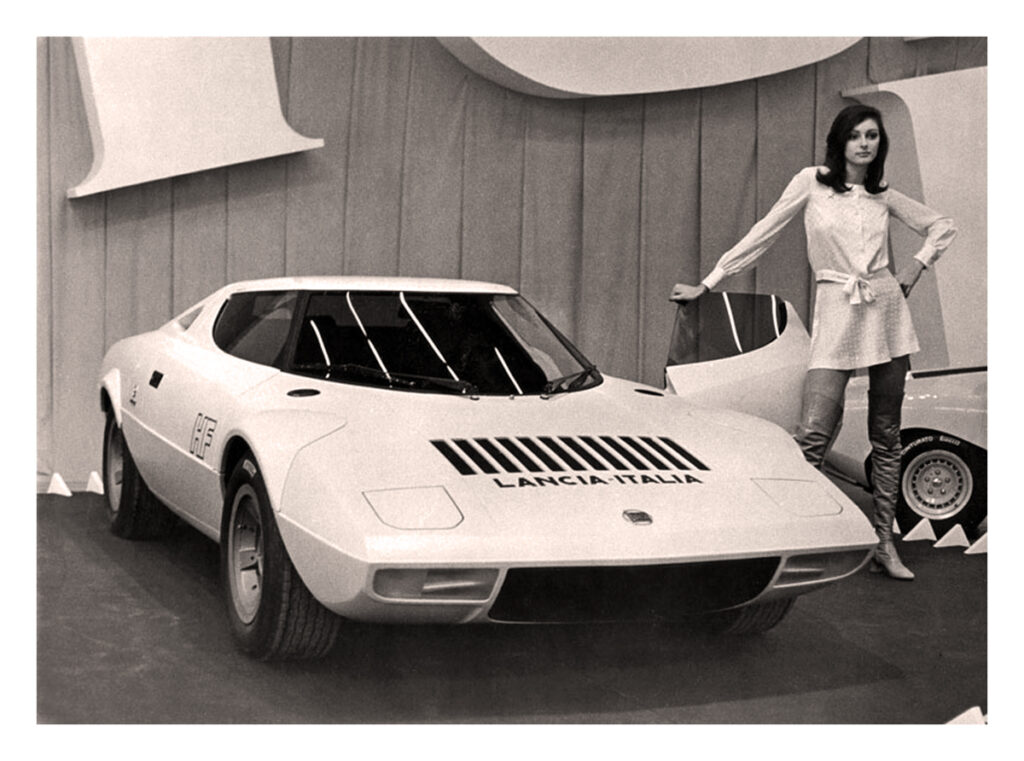
The Lancia Stratos race version mounted Campagnolo alloy wheels with a distinctive star design and different sizes of tires at the front and rear, 205/50-15 and 295/35-15 respectively, this was to ensure excellent rear-end grip and just as much directionality up front. However, on the road version the Lancia marketing department wanted the car to be more of a comfortable granturismo than a sports car, so they replaced the suspension on uniballs with more comfortable silentblocks and demanded that equal wheels be mounted on all four wheels. These modifications changed the behavior of the car so much that it became much more inaccurate and less effective in corners.
As soon as homologation was obtained, the cars were sent to Lancia dealers, who were obliged to take back at least one each. In the midst of the oil crisis, selling the 500 examples of Stratos with thirsty engine, spartan trim and uncomfortable seats for the hefty sum of 10,725,000 liras was so difficult that many dealers got rid of the stock only after years and at huge discounts. Moreover, Lancia did not advertise the road-going Stratos at all; rather it was the Stratos HF that was used as an advertising vehicle.
Disc brakes on the 4-wheel self-ventilating ATE-Girling wheels had no brake booster, unnecessary on a car intended for competition. The two tanks, centrally located, held up to 85 liters of fuel, just enough for a car that traveled just 7 km/liter.
The rear and front parts of the body were made of a single piece of fiberglass, as were the doors, so that they could be opened, and if necessary removed, quickly. Thus excellent accessibility to mechanical parts, vital at rally service points, was also guaranteed. The line was also completely redesigned by Gandini and, while maintaining an extreme wedge design, shared no panels with the Lancia Strato’s Zero. Three fixed spoilers were placed on the car, one front, one rear and one center spoiler to improve aerodynamics.
A choice was made to place the powertrain in a central rear position. Thus the engine and gearbox, the same as those from the Ferrari Dino 246 GT, combined with a ZF limited slip differential, were mounted transversely, exactly as on the car from which they came.
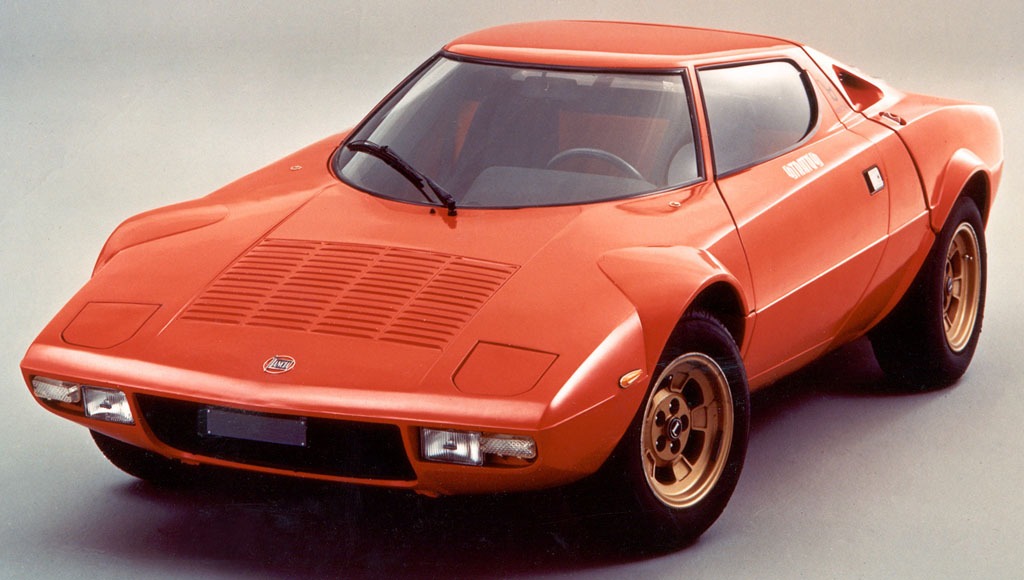
This engine was the latest evolution of the well-known 65° V-shaped 6-cylinder, 2418 cm³, with cast-iron cylinder block and light alloy twin-shaft cylinder head fed by 3 inverted twin-body Weber 40 IDF carburetors. On the road version, with a 9:1 compression ratio, it delivered a maximum power output of 190 hp at 7000 rpm and a maximum torque of 23 kgm at 4000 rpm. With the favorable power-to-weight ratio of 5.2 kg/hp, the car could reach 100 km/h in less than 7 seconds and could go from 0 to 160 km/h in about 18 seconds.
The power train was already good, but it also brought with it some flaws. In right-hand turns taken at high speed, the (side) bowl of the Weber 40 DCN carburetors mounted on the Ferrari Dino cars was not fed enough due to a centrifugal effect and caused fuel gaps. These carburetors were designed to be mounted on longitudinal engines (the large front-mounted Ferrari V12s in the longitudinal position). Lancia and Weber had to redesign the intake manifold and adopt Weber IDF carburetors (now with a center tank) after discarding the idea of mechanical injection for a reason of cost and ease of tuning. In addition, the transmission was in lockstep with the engine, and in case of gearbox failure, it was impossible to intervene promptly in the harsh conditions of the rally points.
The V6 Dino was then tuned for racing to a maximum power output of 280 hp at 8000 rpm, and a maximum torque of 37 kgm at 5300 rpm with three Weber 48 DCF double-body inverted carburetors. In this case the twin-shaft V6 had only two valves per cylinder; a 4-valve-per-cylinder version (later banned along with other upgrades in 1978) was also immediately planned and then developed to gain another 40 hp and thus reach an impressive 320 hp at 8500 rpm. Finally, a version with 560 hp supercharged with a KKK turbocharger and Kugelfischer injection was also created by Carlo Facetti for Endurance racing.
It has already been mentioned that the engine and transmission of the Ferrari Dino 246 GT were adopted in the final version, but the situation was more complicated than expected. The supply of the engines was in fact granted to Lancia only “at the last minute,” on December 14, 1972, by Enzo Ferrari to Pier Ugo Gobbato after the latter, tired of the various difficulties encountered with Ferrari, had sounded out the path of Maserati engines, in particular the 3.0 V6 from Maserati Merak. Only the risk of Trident engines being fitted caused all the resistance still present in Maranello to fall away.
Throughout 1972 in fact there were several tugs and pulls between Turin and Maranello; on February 2 Enzo Ferrari telephoned Gobbato to congratulate him on the victory of the Fulvia Coupé in the Monte Carlo Rally and gave his willingness to supply 500 engines for the Stratos; however, in early March, difficulties arose with the supply of the engines by the Maranello production managers. On May 21, the Ferrari 312 PB won the Targa Florio with Arturo Merzario and Sandro Munari driving, “on loan” from Lancia, and Ferrari delivered 10 Dino engines to the Lancia Racing Department to be tuned and mounted on Stratos prototypes. In early November a Lancia Stratos makes its debut in international rallies, at the Tour de Corse, among the Group 5 prototypes, while there is still no certainty that the engines needed for the production of 500 cars will be supplied. Finally in December, after Gobbato’s phone call to Modena, the last qualms fell away, and on February 11, 1973 the legal agreement with Ferrari was signed.
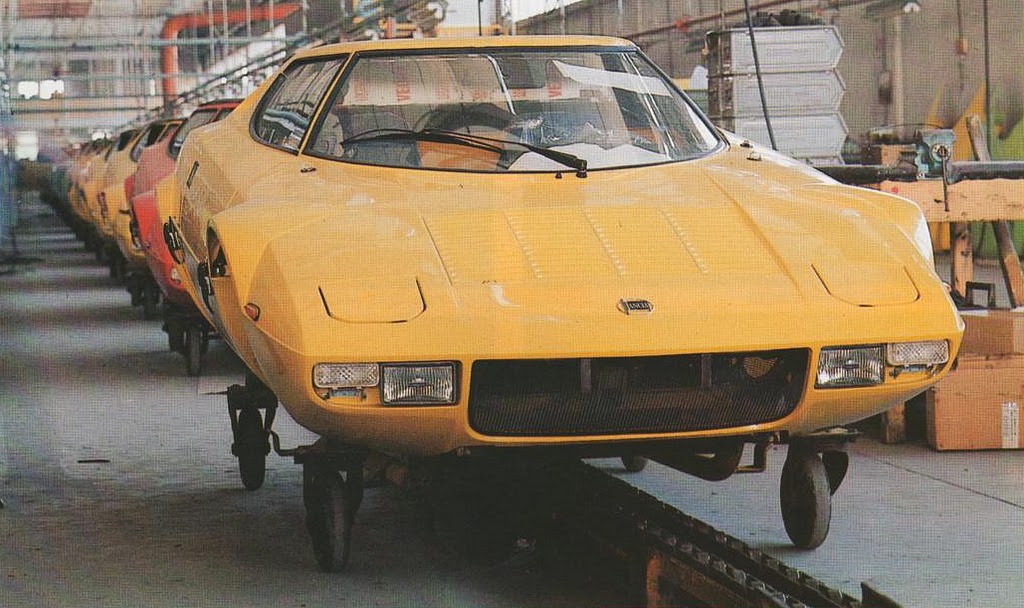
The whole of 1972, however, was not wasted time because it was very useful in developing the car and making it competitive on all kinds of tracks, from the hot dirt roads of Kenya to the cold Finnish ice, via the Monaco asphalt. Under the direction of Cesare Fiorio and Gianni Tonti, drivers and engineers such as Sandro Munari, Claudio Maglioli, Carlo Facetti, Mike Parkes, Gianni Gariboldi, Giampaolo Dallara, Sergio Camuffo, Francesco De Virgilio, Francesco Faleo, and Nicola Materazzi actively collaborated for the ultimate success of the newborn. Extensive road tests were also conducted with the support of Pirelli, which developed tires specifically for dirt and asphalt.
Once the engines were obtained, the race to produce the cars needed for homologation in Group 4 began, however, slow production activity at the Bertone plant in Grugliasco forced the Stratos to compete as a Group 5 until the minimum number of units needed (500) was reached. In this regard, the homologation statement signed by Fiorio states that as of July 23, 1974, 515 units had been built. The veracity of this statement was questioned by many; on the other hand, 17 months later, the minimum required threshold was lowered to 400 speciments, thus making any controversy useless.
The Lancia Sibilo
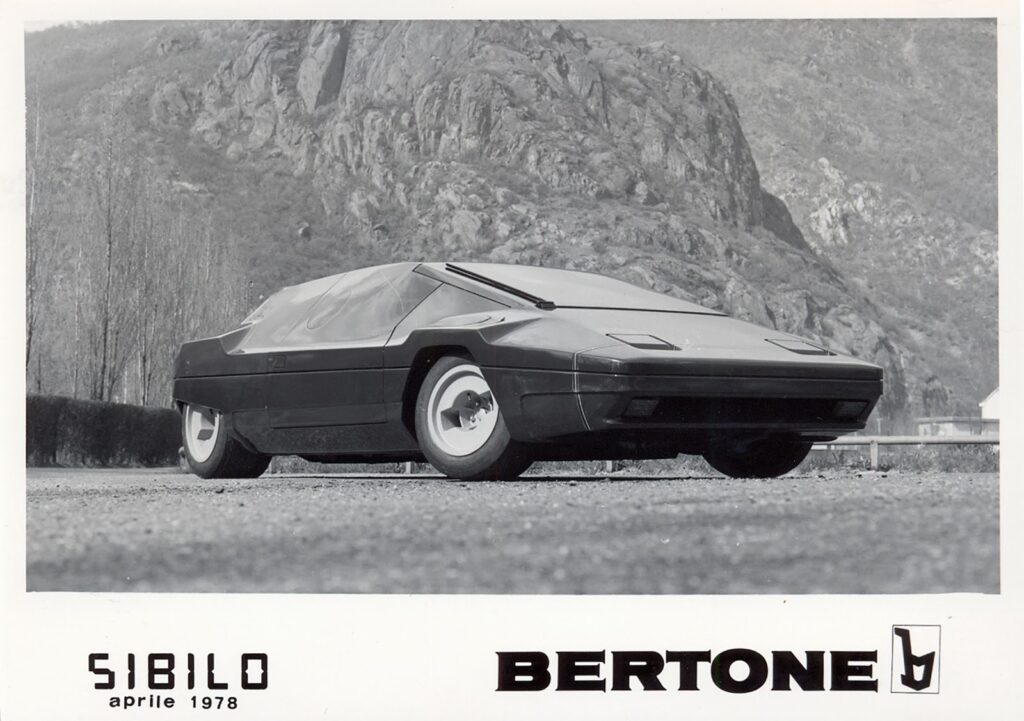
The Lancia Sibilo is a concept car designed by Marcello Gandini and built by Carrozzeria Bertone on the basis of the Lancia Stratos in 1978. The Sibilo inherits all the mechanicals directly from the Stratos except for the wheelbase, lengthened by 10 cm. The prototype is intended to be a “monolithic” sculpture with sharp, square lines that includes all elements and accessories in a single surface. Even the polycarbonate windows blend with the body; the chocolate-colored paint does not stop on the panels but is also shaded on the windows themselves, harmoniously incorporating them into the whole. On the latter there is a small circular portion as an opening porthole to ventilate the passenger compartment. Today the Lancia Sibilo is part of the Lopresto Collection.
The New Stratos
In late November 2010, Pininfarina created a one-off called the New Stratos, inspired by the Lancia Stratos and based on the Ferrari F430 Scuderia; the car was commissioned by automotive entrepreneur and classic car collector Michael Stoschek. After its design and construction, the model passed and received TÜV approval to drive on the road.
In 2018, MAT Manifattura Automobili Torino announced the limited series production of the New Stratos, “estimated at 25 examples,” built upon the car’s debut at the 2018 Geneva Motor Show.

